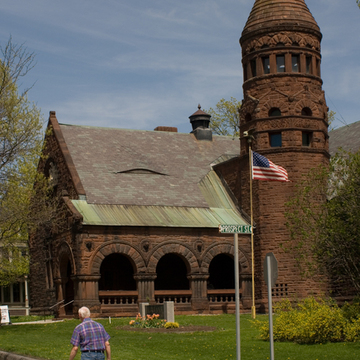When Franklin Fairbanks's ornithological and natural history collections outgrew his mansion, he commissioned Lambert Packard to design a second Richardsonian Romanesque building, across Main Street from North Congregational Church (CA17). The museum is a U-shaped building of dark red Longmeadow sandstone. It was constructed in two phases, beginning with the north and east ell with a three-and-a-half-story stair tower in its reentrant angle; this was followed by a south wing, joined with a more modest tourelle. The building's model was H. H. Richardson's Converse Memorial Library (1883–1885) in Malden, Massachusetts. For the museum, Packard extended the loggia forward from its wing and finished it with a gabled facade, elevated the tower with an additional circular arcaded stage below the conical cap, and enlivened the roof with eyebrow dormers. Among the finely carved Romanesque-styled ornamentation, he included a gable tympanum relief of “Science” and portrait roundels of Louis Aggasiz, John James Audubon, and Alexander von Humboldt. The interior, with its fine oak woodwork and elaborate brick and terra-cotta fireplaces, also recalls Richardson's libraries, and especially the interior of the Ames Free Library (1877–1879) in North Easton, Massachusetts. The barrel-vaulted main hall, illuminated by large arched geometric stained glass windows and, originally, by sash at its upper level (now filled to provide more exhibition space), has a continuous gallery lined with handsomely crafted cases for birds and curios. In its remarkable combination of intact architecture and period collections this building is a worthy companion to the St. Johnsbury Athenaeum (CA13).
You are here
Fairbanks Museum of Natural Science
If SAH Archipedia has been useful to you, please consider supporting it.
SAH Archipedia tells the story of the United States through its buildings, landscapes, and cities. This freely available resource empowers the public with authoritative knowledge that deepens their understanding and appreciation of the built environment. But the Society of Architectural Historians, which created SAH Archipedia with University of Virginia Press, needs your support to maintain the high-caliber research, writing, photography, cartography, editing, design, and programming that make SAH Archipedia a trusted online resource available to all who value the history of place, heritage tourism, and learning.


















